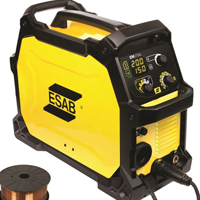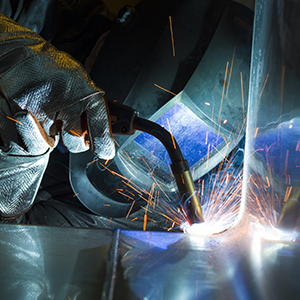Oxy-acetylene welding, often referred to as oxy-acetylene or gas welding, has been a cornerstone of metalworking for over a century. This process involves the combination of oxygen and acetylene gases to create a high-temperature flame that can melt and join metals. While it has been largely superseded by newer technologies in many applications, oxy-acetylene welding remains a valuable tool in certain industries and tasks.
Early History and Discovery
The history of oxy-acetylene welding begins with Humphry Davy, a renowned chemist who discovered chlorine and invented a safety lantern. His younger cousin, Edmund Davy, worked as his lab assistant and shared his passion for scientific exploration. It was during Edmund's time in the lab that a fortuitous accident led to the discovery of oxy-acetylene welding. This accidental breakthrough marked a significant milestone in the history of welding technology.
In 1836, while working in his laboratory, Edmund was conducting experiments to isolate potassium metal. During one of these experiments, he heated potassium carbonate at a high temperature, producing a residue that reacted with water to form a flammable gas.
Edmund, however, did not fully recognize the potential of this new gas. He believed it could be used as a source of artificial lighting but struggled with controlling the flame and heat. As time passed, his findings were largely forgotten.
It was not until 1860, three years after Edmund Davy's death, that the French chemist Marcellin Berthelot rediscovered acetylene and gave it its name. Berthelot conducted further experiments with the gas, exploring its properties and potential applications.
Despite Berthelot's work, the true potential of acetylene as a welding fuel remained untapped for several decades. In the early 20th century, Berthelot’s work resurfaced, and the oxy-acetylene welding process was developed.
The Rise of Oxy-acetylene Welding
In 1903, French engineers Edmond Fouché and Charles Picard made a groundbreaking discovery. They realized that combining acetylene with oxygen could produce a flame that burned at an incredibly high temperature — hotter than any previously achievable.
This breakthrough was a game-changer for the field of metalworking. Prior to the development of oxy-acetylene welding, welding techniques were often crude and inefficient. Forging, for example, involved heating metals to a high temperature and then hammering them together to join them. This method was labor-intensive, time-consuming, and often resulted in uneven joints.
Oxy-acetylene welding, on the other hand, offered a more precise and efficient way to join metals. The intense heat of the acetylene-oxygen flame allowed for clean, controlled melting and fusion of the metals, resulting in strong and durable joints. This technological advancement revolutionized the way metals were worked and fabricated. It provided a portable and versatile method for cutting, welding, and heating metals, revolutionizing industries such as construction, manufacturing, and shipbuilding.
During the early and mid-20th centuries, oxy-acetylene welding was the dominant method for metalworking. Its versatility and relative ease of use made it a popular choice for a wide range of applications, from repairing farm equipment to constructing large steel structures.
Key Advantages and Limitations of Oxy-acetylene Welding
As newer and more advanced methods of welding begin to surface, the popularity of oxy-acetylene welding starts to decline. However, while not as widely used as it once was, oxy-acetylene welding still offers several distinct advantages that make it a valuable tool in certain applications. But, like any welding process, it also has its limitations.
Advantages
- Portability: One of the primary benefits of oxy-acetylene welding is its portability. The equipment is relatively compact and can be easily transported to job sites. This makes it ideal for on-site repairs, maintenance, and construction projects where access to electricity or other power sources may be limited.
- Versatility: Oxy-acetylene welding can be used to join a wide range of metals, including steel, cast iron, and nonferrous alloys. This versatility makes it a valuable tool for a variety of applications.
- Precision: With proper technique and skill, oxy-acetylene welding can provide a high degree of precision and control. The ability to precisely control the flame allows for accurate cutting and welding of metals.
- Cost-effectiveness: In some cases, oxy-acetylene welding can be a cost-effective option compared to other welding methods. The relatively low cost of oxy-acetylene welding equipment and consumables can make it a viable choice for smaller projects or when budget constraints are a concern.
Limitations and Challenges
- Safety Concerns: The use of flammable gases, such as acetylene and oxygen, poses significant safety risks. Proper handling, storage, and ventilation are essential to prevent accidents.
- Efficiency: Compared to newer technologies like arc welding and plasma cutting, oxy-acetylene welding can be less efficient in terms of speed and energy consumption. This can be a disadvantage for large-scale production or projects where time and energy efficiency are critical.
- Skill Requirement: Oxy-acetylene welding requires a high level of skill and expertise to achieve high-quality results. Operators must have a thorough understanding of the process, including the proper techniques for flame adjustment, metal preparation, and joint design.
- Environmental Impact: The release of combustion gases, such as carbon dioxide and carbon monoxide, can have negative environmental impacts. However, with proper ventilation and emissions control measures, these impacts can be minimized.
Modern Applications
While oxy-acetylene welding has been largely replaced by newer technologies in many industrial applications, it remains a valuable tool in certain niche areas. Some common uses include:
- Repair and Maintenance: Oxy-acetylene welding is often used to repair damaged equipment, such as pipes, tanks, and machinery.
- Art and Fabrication: Artists and craftspeople may use oxy-acetylene welding to create unique metal sculptures and objects.
- Custom Fabrication: The process can be used for custom fabrication tasks that require precise cutting and joining of metals.
- Emergency Repairs: Oxy-acetylene welding can be a valuable tool for emergency repairs in situations where other welding methods are not available.
The Legacy and Future of Oxy-acetylene Welding
Beyond its practical applications, oxy-acetylene welding holds significant historical value. Its development marked a major technological advancement and contributed to the progress of various industries. The legacy of oxy-acetylene welding serves as a reminder of the ingenuity and innovation that have shaped the modern world.
While oxy-acetylene welding may not be as widely used as it once was, its enduring utility and historical significance make it a fascinating subject for those interested in the evolution of technology. As a cornerstone of modern metalworking, oxy-acetylene welding has left an indelible mark on the field and continues to be a valuable tool for a variety of applications.






